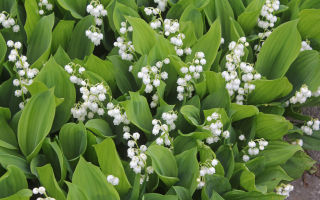Content
- 1 What it looks like and where it grows
- 2 The chemical composition of lily of the valley may
- 3 What heals and how is lily of the valley useful for human health
- 4 Preparation and application methods
- 5 The use of lily of the valley in traditional medicine
- 6 Application in cosmetology
- 7 Contraindications to the use of lily of the valley May
- 8 Collection and procurement
- 9 Conclusion
The medicinal properties of lily of the valley are actively used by traditional medicine. The plant can be very dangerous, but when used correctly, it brings benefits to the body.
What it looks like and where it grows
May lily of the valley is a perennial herb up to 30 cm tall. It is the only representative of the genus of the same name and belongs to the Asparagus family. It has an underground horizontal rhizome, two or three large broad-lanceolate basal plates rise above the ground, which are surrounded by a pale lower leaf. A peduncle protrudes from the corner of the latter; from May to June, a brush of 6-20 small bell-shaped flowers appears on it. Perennial buds are white, sometimes pale pink, no more than 1 cm in length.
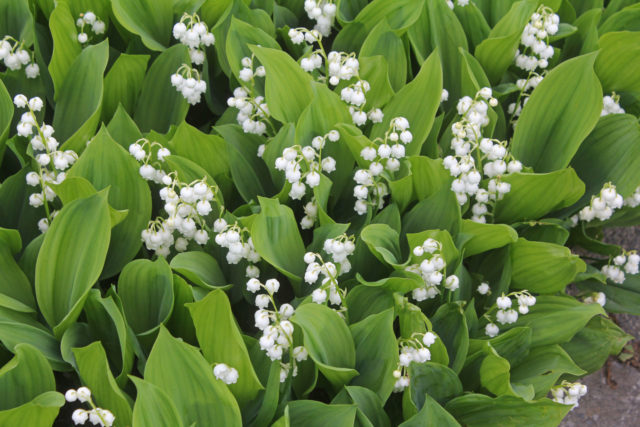
The plant bears fruit in June or early July. Spherical orange-red berries with round seeds inside can hold on to the peduncle for a long time.
May lily of the valley is very unpretentious, grows in the temperate climate of Europe and North America, is found in the mountains of Asia and Siberia. Selects mainly the edges of coniferous and deciduous forests, meadows and river banks.
The chemical composition of lily of the valley may
The healing properties of forest lily of the valley are highly valued in official and folk medicine due to the rich chemical composition of the plant. Leaves, flowers and berries contain:
- quercetin and kaempferol;
- starch and essential oils;
- potassium, selenium and zinc;
- vitamin C;
- nickel and cobalt;
- sugars and steroidal saponins;
- numerous cardiac glycosides;
- lycopene;
- citric and malic acids;
- molybdenum;
- coumarins;
- alkaloids.
The benefits and harms of lily of the valley for humans are related to each other; it is dangerous to use the plant in large quantities. But in small doses, it helps to heal many ailments, including very serious ones.
What heals and how is lily of the valley useful for human health
All parts of the May lily of the valley are of medical value. Both the green herb and the fruit have medicinal uses.
What are the benefits of lily of the valley berries
The fruits of the May lily of the valley are very poisonous and dangerous, they contain the glycoside convallatoxin, which disrupts the work of the heart. Just five berries can be fatal if consumed whole.
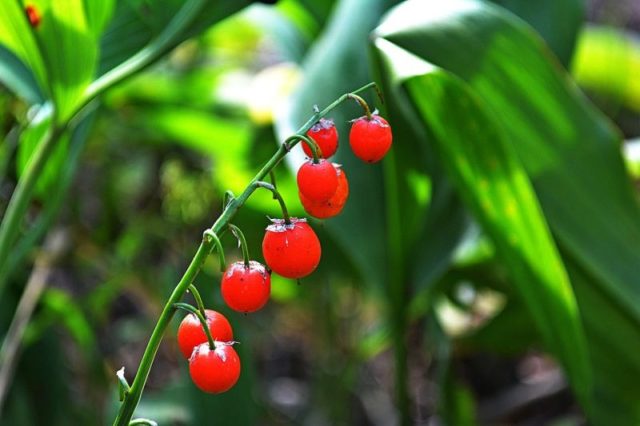
Despite this, the use of lily of the valley in medicine extends, including to the fruits of the plant. They have strong anti-febrile and anticonvulsant properties.
Medicinal properties of lily of the valley flowers
Lily of the valley flowers help with malfunctions of the nervous system and headaches.In particular, powder from buds relieves migraine well, just inhale its aroma for several minutes. Means based on flowers are taken for colds, in some cases, infusions and decoctions help even with paralysis.
Why are lily of the valley leaves in May useful?
Drinks made from May lily of the valley leaves have pronounced soothing properties. They are used to treat neuroses, as well as in the treatment of epilepsy, heart disease and thyroid malfunction. The beneficial properties of lily of the valley leaves when applied externally promote rapid healing of wounds and burns.
The healing properties of lily of the valley root
The roots contain a large amount of glycosides and alkaloids, so they are used in the smallest doses. Traditional medicine uses the underground part of the plant to treat seizures, weakened blood vessels and heart problems.
How do lily of the valley preparations help?
Perennial extracts are in demand in official and alternative medicine. They are appointed:
- with heart failure;
- with increased pressure;
- with Graves' disease;
- with overwork and loss of strength;
- with sore throat;
- with rheumatism;
- with glaucoma;
- with migraines.
The remedies are beneficial for a tendency to depression, improve the condition with menopause.
Preparation and application methods
Leaves, flowers and berries are used in the form of water and alcohol preparations. It is not difficult to prepare them at home, but it is important to first study the healing properties and rules for using lily of the valley.
Lily of the valley tincture
The strong tincture of the plant is beneficial for tachycardia, heart failure, urogenital inflammation and stomach problems. Prepare the product as follows:
- fresh flowers of the plant are poured into a glass jar of 0.5 liters by a third;
- fill the container to the top with 70% alcohol;
- close the jar with a lid;
- put in a dark place for two weeks.
From time to time, the container is removed and shaken. After the expiration date, you need to pass the medicine through gauze for filtration. Take the remedy 15 drops three times a day, diluting the drug in 50 ml of water.
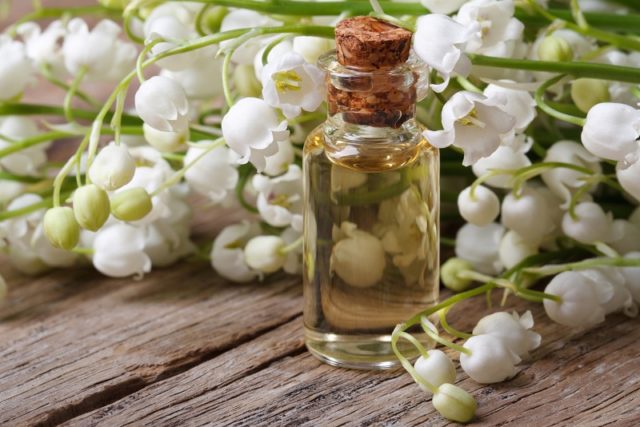
Infusion
The properties of lily of the valley flowers are used to remove fluid in case of edema. Diuretic infusion is done as follows:
- a large spoonful of dried flowers or leaves is crushed;
- pour 500 ml of boiling water in a thermos;
- close with a lid and leave to infuse for ten hours.
The finished drink must be passed through folded gauze. Use the product twice a day, 15 ml.
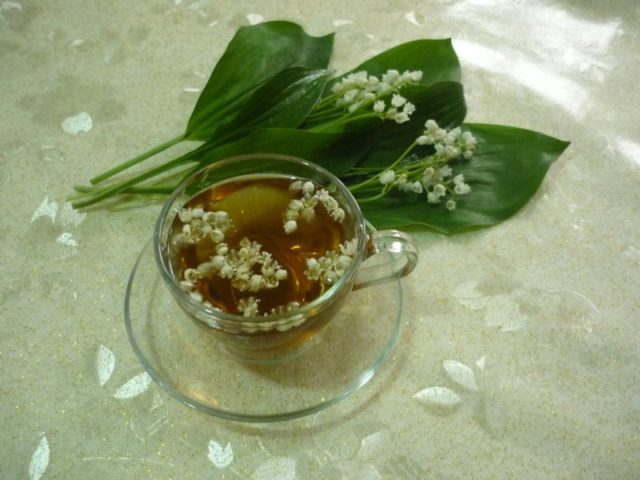
Decoction
A strong decoction of flowers or leaf plates is used internally and externally. It is beneficial in the form of compresses for joint ailments and glaucoma, relieves the condition for colds and menopause.
To prepare the product you need:
- pour 15 g of dry leaves with a glass of hot liquid;
- boil in a water bath for 20 minutes;
- cool and pass through a sieve or cheesecloth.
The tool is taken three times a day, 10 ml.
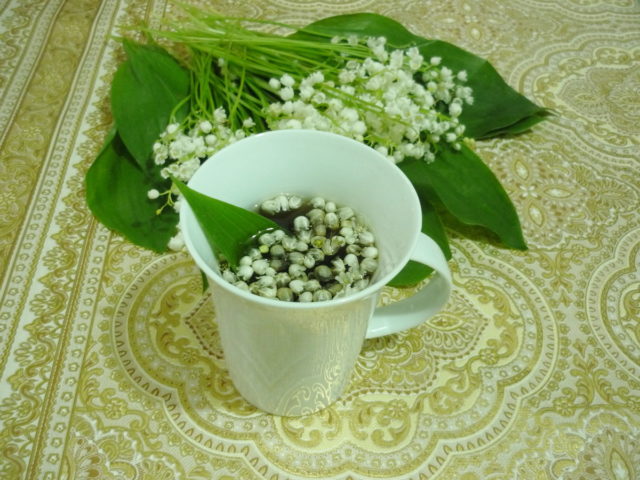
Tea
Perennial flower tea has firming and relaxing properties. It is used for insomnia and depression, and the recipe for the drink looks like this:
- four fresh flowers of the plant are placed in a cup;
- pour 200 ml of hot, but not boiling water;
- insist for ten minutes, and then remove the buds.
They drink the remedy instead of regular tea, but no more than two cups a day.

The use of lily of the valley in traditional medicine
Home medicine offers several effective recipes using the plant. When using medicines, it is necessary to strictly observe the indicated dosages and preparation schemes.
With glaucoma
For the treatment of eye diseases, a prefabricated healing infusion is used. They do it like this:
- grind 1/3 cup nettle and a small spoonful of lily of the valley leaves;
- pour the herbal mixture with a glass of boiling water;
- cover and put away in a dark place for nine hours.
A pinch of baking soda is added to the finished product and stirred thoroughly. Twice a day, a cotton pad is moistened in the solution and applied to the eyes for ten minutes.
With neuroses
For disorders of the nervous system, an alcoholic tincture of plant flowers is beneficial. They do it like this:
- a glass vessel is filled by a third with lily of the valley buds;
- poured to the top with alcohol 96%;
- cork the bottle and put it in a dark place for two weeks;
- Shake the product periodically.
The finished tincture should acquire a yellowish translucent shade. It is passed through cheesecloth and consumed ten drops three times a day on a full stomach.
With hypertension
The medicinal plant lily of the valley is used in the form of a tincture to lower blood pressure. Traditional medicine offers the following recipe:
- 30 dried flowers of the plant are ground with a mortar;
- in a glass container, pour a glass of vodka;
- when closed, they are removed for a week in a dark place.
Filter the finished product and drink 15 drops per 50 ml of water just once a day. You can take the tincture until the pressure normalizes, but no longer than two weeks.
For epilepsy
Perennial tincture on white wine has a good anticonvulsant effect.
They do it like this:
- 30 fresh flowers of the plant are washed, dried and ground into gruel;
- raw materials are mixed with wine in a ratio of 1:10;
- add honey at the rate of three large spoons per 500 ml of tincture;
- close the container with a lid and put in a dark place for two weeks.
The finished product is filtered from the sediment and consumed three times a day in the amount of a small spoon.

With rheumatism
Tincture of lily of the valley is used externally to treat joints. It relieves inflammation and swelling and soothes pain. The recipe looks like this:
- fresh flowers of the plant are crushed in a volume of 50 g and pour 500 ml of vodka;
- when closed, they are removed in a dark place for 14 days;
- filter the finished product through cheesecloth.
The tincture is mainly applied externally, a bandage or gauze is soaked in the product and applied to the diseased area for two hours. It is advisable to repeat the procedure twice a day.
For insomnia
The water infusion of the plant has a calming effect and improves sleep. To prepare the product you need:
- pour a large spoonful of dried flowers into a glass container;
- pour 250 ml of boiling water;
- wrap with a towel and insist in this form for ten hours.
After the time has elapsed, the infusion must be passed through cheesecloth. They drink it in two large spoons up to three times a day.
For heart ailments
Lily of the valley finds medical use for tachycardia and angina pectoris, although it can only be used with the permission of a doctor. For medicinal purposes, the following collection is used:
- mix 50 g of lily of the valley buds with an equal number of hawthorn inflorescences;
- add 25 g of seeds of wild carrots and motherwort;
- pour the ingredients with vodka in a ratio of 1: 5.
The tool is infused for two weeks away from sunlight, and then filtered. You need to take the drug 20 drops three times a day, the medicine is first diluted in a small amount of water.
With diseases of the thyroid gland
Lily of the valley treatment is beneficial for endocrine disorders caused by malfunctioning of the thyroid gland. The following infusion is usually prepared:
- mix 50 g of lily of the valley leaves, cocklebur and parsley;
- grind the components and measure out a small spoonful of the collection;
- pour a glass of hot water and incubate under a lid for ten minutes.
The filtered drink is consumed 15 ml three times a day.
Application in cosmetology
The healing properties of May lily of the valley are used for skin and hair care. First of all, a decoction of leaves and flowers, half diluted with clean water, is beneficial. The product can be used to rinse the curls after each shampoo to strengthen the roots, regulate the oiliness of the skin and get rid of dandruff.
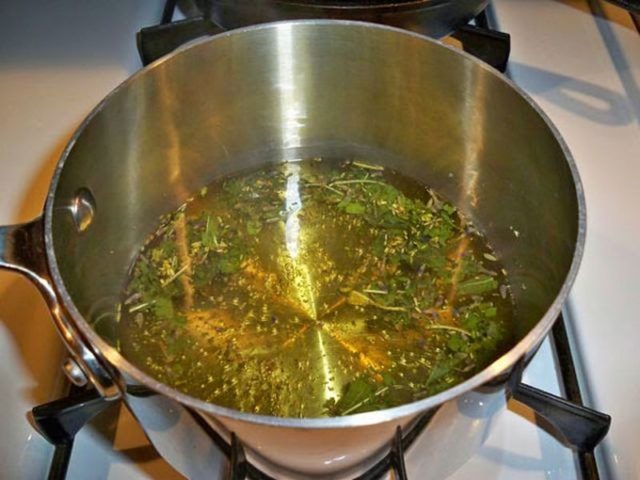
Infusions of lily of the valley leaves are used to wipe the epidermis with a tendency to irritation and rashes. The active substances in the plant help get rid of acne and blackheads, tone and refresh the skin. Since lily of the valley can be harmful even when applied externally, only products with a low concentration should be used. Do not leave them on the skin for a long time.
Contraindications to the use of lily of the valley May
A useful but toxic lily of the valley has strict contraindications. You cannot use it:
- with severe heart ailments and inflammatory diseases of the myocardium;
- during pregnancy;
- during lactation;
- with cardiosclerosis;
- with severe liver pathologies;
- with an individual allergy to a plant;
- with exacerbations of gastrointestinal ailments.
A strict contraindication for lily of the valley herb is children and adolescents under 18 years of age. When using traditional medicines, you need to adhere to the minimum dosages. Excessive amounts of drugs cause diarrhea and vomiting, as well as migraines and even fainting.
The benefits and harms of the lily of the valley aroma are ambiguous; if inhaled for a long time, the smell can cause headaches and nausea. It is better not to leave the essential oil of the plant and fresh flowers in the room for a long time without airing.
Collection and procurement
Lily of the valley flowers are harvested in May and June, and the leaves are harvested about two weeks before the buds begin to bloom. The aerial part of the plant is cut with a sharp knife a few centimeters from the ground. The roots are not touched if they are not needed for medicinal purposes. In this case, the plant will not die and will be able to give new shoots.
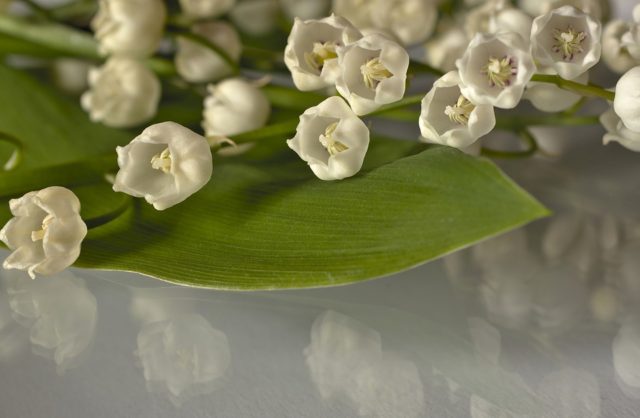
Immediately after harvesting, flowers and leaves are dried in the fresh air in the shade or in an electric dryer at a temperature not exceeding 50 ° C. When the workpieces become brittle, they can be laid out in paper bags and stored in a dark cabinet.
Conclusion
The healing properties of lily of the valley are inextricably linked with its dangerous qualities. The plant requires a very careful approach, but it can improve health when followed by reliable recipes.

